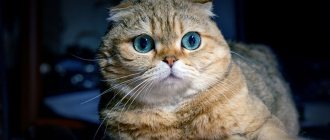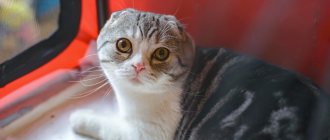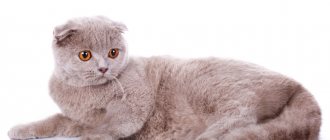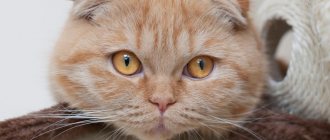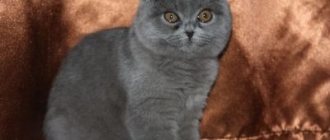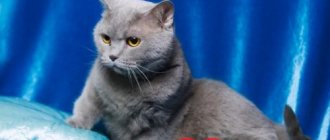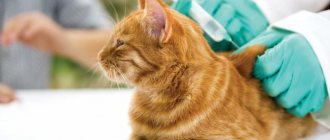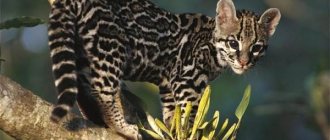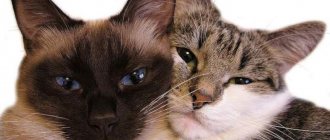Folding ears are associated with the specific structure of the ears. This property was recorded in Scotland in 1961, when breeders began to deliberately breed lop-eared kittens. Hence the second name of this breed – Scottish.
Scientists have discovered that this ear structure is a gene mutation, with lop ears being a dominant gene. When two fold-eared cats are crossed, weak kittens are born. In order for the offspring to be healthy, one parent must have fold ears, and the other must have straight ears. When purchasing, find out which cats your future pet comes from. This will save you from choosing a purebred but sick kitten.
Newborn fold kittens
Kittens in a litter from a fold-eared parent and a straight-eared parent are different, but they can be distinguished from each other after 2-3 weeks.
British and Scottish ears
Important! It is recommended to buy a fold kitten when it is 6 weeks old. At earlier stages, you risk paying a large sum and finding that the kitten's ears will straighten over time.
External signs of lop ears
A fold-eared kitten has structural features of the entire body, and not just the ears. These include:
- The nose is without humps, which can be determined by touch.
- The tail is smooth, without humps or knots.
- Wide muzzle.
- Round head.
- Small cheeks.
- Wide eye set.
- Large chest.
- The legs and tail are shorter and larger than those of their straight-eared counterparts.
- Plush wool.
External signs of fold-eared cats
Interesting! Fold cats are long-haired - Highland Folds, and short-haired - Scottish Folds.
Types of British and Scottish cats
Highland fold
Scottish fold
When ears drop: timing
After birth, a kitten’s ears do not yet acquire the necessary shape, so it is difficult to draw conclusions about what kind of cat was born. In a fold-eared cat, already on the 18th day after birth, folds form, and the shell itself is slightly tilted forward, opposite from the top of the head. The number of days can range from 21 to 24 days. The most preferable is a triple degree of ear bending. Both hearing organs must descend.
If the ends do not fall equally or unevenly, then over time they may stand up completely. Ears also rise when there are less than 1-2 folds, so the standard kitten should have 3 of them. It is best to see that the ears are erect or curled when the small cat is 3-4 months old. However, breeders recommend adopting a lop-eared baby at 4-5 months, when the teeth change and the baby's fur falls out.
Loss of characteristic: when the ears rise
Straight-eared kittens are called straights, and fold-eared kittens are called folds. The clear difference between them lies in the presence and number of folds on the ears. One fold causes the ears to straighten over time. This does not mean that the kitten is straight. To answer the question about his breed, an examination is carried out. It is especially important for owners who plan to crossbreed kittens. An incorrect conclusion about the straightness of an animal leads to the crossing of two lop-eared individuals and sick offspring. If there are two folds, then it is impossible to predict the outcome: the kitten can remain fold-eared with the same success as become straight-eared. Three folds ensure the ears don't straighten out.
External differences between British and Scottish cats
Folds with erect ears are sterilized to prevent the transmission of a dominant gene that has lost visual expression.
There is a clear sign that distinguishes a fold-eared cat with erect ears from a straight-eared one: the size of the ears. The first one has smaller ones.
Temporary changes in the position of the ears are also possible, the cause of which is weather conditions. The heat causes the Fold's ears to rise slightly.
Important! To purchase fold-eared kittens, choose a time of year with moderate temperatures.
In addition, the ears of the folds also rise in females after giving birth.
Video - Scottish Fold cat
Straights and folds
The Scottish Fold cat breed, characterized by ears with an abnormal structure, became known in the first half of the 60s of the 20th century.
It appeared a little earlier, but did not immediately deserve the attention of scientists. In the 60s Thanks to scientific research, it was found that lop ears appear due to a gene mutation.
By crossing two identically fold-eared individuals, as scientific experiments have shown, it is almost impossible to get healthy kittens with the same unusual ears. The offspring are weak, non-viable, and have many genetic defects.
To get a healthy Scottish Fold kitten, breeders resort to tricks. They cross a fold-eared individual (Scottish Fold) with a straight-eared Scot (Scottish Straight). These breeds are considered related, but at the same time they are independent. The offspring from such a union turns out strong and healthy.
The birth of a viable kitten that meets the standards of the Scottish Fold breed is possible if its parents have the following characteristics:
We also recommend reading:
8 interesting facts about cat tails 13 products from Aliexpress that your cat will love How to make friends with pets and avoid quarrels and troubles? Cat, let me sleep: how to wean an animal from waking up its owners early in the morning?
- flexibility of the tail (the key to a healthy spine);
- uniformity of color, which should be the same in females and males;
- having ear folds.
The offspring born from the “correct” parents can either have the ear structure typical of Scottish Folds or be straight-eared, like Scottish Straights. It is not possible to determine this in the first weeks of a baby’s life. Fold does not appear until kittens reach three weeks of age. The ears of straights and folds at this stage of development have the same appearance.
Adding to the family: how to care for a mother and her newborns
In the first weeks after the birth of kittens, providing proper care is the key to healthy babies and cats. The list of necessary actions on the part of the owners is as follows:
- Provide a warm, dry box for mother and kittens.
- Place a white sheet over it to help track your cat's waste.
- Provide your cat with a balanced diet.
- Organize constant access to water for babies and mothers.
- Do not try to separate the kittens from the cat.
The last point determines the development of the kitten and its viability. If you separate small pets from their parents, you can cause physical harm to them, because the bones are still fragile during this period, deprive the kittens of milk, which is responsible for their immunity, and disrupt their psychological state.
Creating favorable conditions for cats and newborn kittens
How to choose the right one?
There are some recommendations and rules for choosing purebred Scots:
- The animal must be healthy with dense hair, clean eyes and a soft belly to the touch.
- Real folds look cheerful, playful and content.
- It is necessary to have a pedigree and a passport of the animal, especially for its participation in exhibitions and competitions.
- It is necessary to find out from the breeder who the kitten’s parents are, since their genetics affects the health of the babies.
- A real fold-eared cat will have a high cost. If a seller sells a pet cheaply, then you need to think about whether it is defective.
By following these rules, you can easily choose a pet with good health. If you want to make an affectionate, gentle, playful friend, following all the recommendations, this breed is better suited. In order to quickly and easily make friends with your pet, you need to carefully watch the reaction and behavior. It is possible to determine a suitable cat this way: if it does not attack a person, does not snort, and does not try to run away. If a lop-eared pet purrs, then this is a sure sign of the beginning of friendship between him and the future owner.
This characteristic of the Scottish cat breed will help you get your bearings and understand whether they are really offering you a real purebred kitten or a mestizo. But first, a photo, because it’s better to see once than to hear seven times. Let's see what a Scottish fold and straight-eared cat looks like and a real fold-eared cat.
The first months of life of Scottish Fold kittens
In the first weeks of life, kittens go through stages from helplessness and huddling around their mother to independent activity and exploration of their environment.
On day 10, their eyes open: they feel more confident and begin to crawl around the cat. After a month, the kittens are fed food that will be their diet throughout their lives. At the same time, they leave the boxes that served them as shelter during the helpless period of life and master the surfaces. This is a favorable period for training a kitten to use a litter tray.
Color genetics
Kittens' eye color gradually changes: from dull blue to their real color. This process takes up to 2 years and is called reblooming. The inclusions appear first, which then spread and provide a permanent color. Green eyes take the longest to form.
Fold cats
The first representative of the breed with an abnormal ear structure was officially recorded in 1963, although lop ears appeared earlier. Only from this period did breeders and felinologists begin studying such animals. They unanimously concluded that lop-eared kittens are born due to gene mutation. Through various crosses, it became clear to scientists that when 2 cats that have drooping ears are mated, their offspring have poor health.
Later they began to cross an ordinary straight-eared cat with a fold-eared cat. The babies born to this couple are born healthy and strong. But only after a month of life can you understand what their ears will be like; until this age, it is impossible to distinguish their development.
Close relatives and ancestors of the Scottish Fold are the British Straight-eared cats. Both have a strong body with well-developed muscles. The cervical region and limbs are short, the head is large and round in shape. The cheeks should be clearly pronounced on the muzzle, and a characteristic feature of the breed is the ears, which fit tightly to the head. The difference between lop-eared Scots and straight-eared ones is considered to be that in the former, due to a specific crease in the cartilage, the ears droop down. This trait appears only after the 4th week of life. Scottish Folds have round eyes, their color can match the shade of their coat, but more often they are amber yellow. The tail is elongated and straight, tapering noticeably towards the end. Scottish and British Folds have a dense velor coat with a soft and dense undercoat.
Constant sleep of newborns - an alarming signal or normal development of the body
Newborn kittens sleep up to 22 hours a day. This is not a cause for concern, because at this time the baby’s nervous system is developing. Sleep contributes to the favorable course of this process. In the first months, the kitten should not be separated from its mother and brothers and sisters. If his weight is normal, it means that development is proceeding normally, and constant sleep is conducive to this.
Newborn kittens sleep up to 22 hours a day
You can familiarize yourself with sleep norms for the initial stages of a kitten’s life in the table.
| Age | Image | Number of hours of sleep |
| Newborn | 22 | |
| 3 weeks | 16 | |
| 1 month | 15-20 |
In order for a kitten to switch to nighttime sleep mode, it should be provided with sufficient activity during the day: play, run. Thus, by night he will be tired, sleep will be necessary to restore strength and will coincide with the biorhythms of the owners.
Kitten at birth
Newborn “Scots” do not see, do not hear, and cannot regulate the temperature of their body. Babies have no undercoat - the hairs practically do not warm them. Kittens find it difficult to stand on their feet. Their bones are still very fragile, which is why it is important to treat the animal with care.
Scottish cats sleep all day, and during short periods of wakefulness they suck milk. Sleep is very important for them - at this time the nervous system continues to form. Babies cannot defecate - this process is stimulated by the mother cat, who cleans the “nest” of children’s excrement.
Kittens that have just been born already have a fairly developed sense of smell and touch - they quickly find their mother by smell and feel her nipples with their paws. Along with milk, the cat produces colostrum, which is rich in substances necessary for the formation of stable immunity in babies.
Human concern lies in two aspects: arranging a cozy corner for the cat family, balanced feeding of the mother. The owner changes the bedding and, if necessary, installs a heater or heating pad. Next to the “nest” he places bowls with water and food for the mother, her tray.
In the photo, video - a newborn Scottish:
Periodization of the kitten's life stages. The first stage - mom is nearby
Kittens grow up to 1 year, during which significant changes occur every month. At the same time, 2-2.5 years is the period when the body finally gets stronger and becomes an adult.
| Age | Image | Peculiarities | Recommendations |
| First week | Weight – 100 g. Body length – 9-12 cm. No hearing until the 4th day. Eyes don't open. Undercoat appears. The umbilical cord separates on the 3rd day | Food is mother's milk, which the baby senses through olfactory receptors and consumes naturally. Antibodies contained in cat milk help an unvaccinated kitten resist infections. Do not disturb the unity of the kitten and the cat, so as not to scare the baby | |
| Second week | Weight - 250 g. By the end of this period, the eyes open; at first, the eye color of all kittens is cloudy blue. Attempts to walk, crawl away from the mother by 30-50 cm. | Stroke the kitten gently. Do not cause aggression on the part of the mother cat, who is worried about the younger generation at their first manifestations of independence | |
| Third week | Weight – 300 – 350 g. Support on 4 legs. On days 15-17 they begin to see. Orientation in distances. First milk teeth. Scratching behind the ear. Interest in playing with people | Play with kittens without sudden movements. Do not leave small children and kittens unattended | |
| Fourth week | Weight – 450 g. Approximately 26 teeth | Organize worm prevention. Drink filtered water from shallow bowls. Provide the kitten with constant access to water | |
| Fifth week | The cat reduces the level of care for the baby. The kitten learns to wash itself. The fur becomes brightly colored | Stock up on age-appropriate liquid food. Include solid foods in your diet. Provide the kitten with constant access to food (100 grams of food is the norm). Do not allow your baby to eat from adult bowls. Organize a pet house |
7-12 months
Stages of further development of Scottish:
- 7 months. It's time for puberty. When the first shedding occurs, it is important to comb the fur on time and make sure that the animal does not swallow its own hairs. They offer him cat grass and a special hair removal paste.
- 8 months. Castration and sterilization are carried out.
- 9 months. Scottish already resembles an adult cat, but he can still continue to be given baby food.
- 10 months. Animals actively demand “love acquaintances.” However, mating at such an early age is undesirable - the cat’s body has not yet formed for procreation.
- 11 months. The animal is gradually transferred to adult food. The frequency of lunches is reduced to 3 times a day.
One-year-old “Scots” are no longer growing. However, they continue to develop: gain mass, increase in width, build muscle. This process is completed by 2-2.5 years.
Scottish cats at 9 months:
Photos, videos of Scottish cats at 1 year:
The second stage is independence and growing up
| Age | Image | Peculiarities | Recommendations |
| Sixth week | The final transition from mother's milk to foreign food | Feed the kitten 6 times a day, 40 grams of food at each meal. Observe the animal's stool; if there are any problems, contact a veterinarian after 3 days. | |
| Seventh week | Weight – 550-900 g. Males stand out among females in size | The kitten should not drink its mother's milk. Balance of dry and liquid food | |
| Eighth week | Weight – 750 – 1200 g. All milk teeth. Eats solid food | Separate from mother. Get examined by a veterinarian. Monitor the condition of your ears and eyes. Comb | |
| Ninth week | Forming a type of relationship with the owners | Get vaccinated | |
| Tenth week | Weight – 850-1400 g. Independence. Sensitivity to learning | Do not be aggressive in training | |
| Eleventh week | Research stage: exploring the corners of the apartment | Prevent the kitten from colliding with dangerous objects: close windows, remove small parts, toxic substances | |
| Twelfth week | Weight – 900-1600 g. Change of eyes Pet’s response to its name, to the call for food | Organize repeated prophylaxis against worms. Stop kitten aggression | |
| Thirteenth - fifteenth weeks | Weight – 1.5 kg. Molars appear | Feed 5 times a day. Trim nails regularly | |
| Sixteenth week | Weight – 1.8 kg | Get vaccinated | |
| Five months | Weight – 2 kg | Feed 4 times a day. Get a rabies vaccination | |
| Six months | Strong molars. Dimensions of an adult animal. Puberty | Organize worm prevention. Feed 3 times a day. Sterilize if there is no goal to breed offspring | |
| Seven months | Seasonal molt | Brushing your pet | |
| Eight – nine months | The cat is almost an adult | Sterilize if not done before. Consult your doctor about vaccination | |
| Ten – eleven months | Adult phase of life | Include food for adult cats in the diet |
Cat vaccination periods
Important! When the cat turns one year old, his diet should consist only of food for adults, and meals should be reduced to 2 per day.
Choosing food for a Scottish kitten
Homemade products
With age, Scottish cats may develop obesity or urolithiasis and obesity if not properly cared for. Home feeding should be ideally balanced with natural products. The diet includes:
- Lean meat. Scottish kittens are fed it daily in the form of mince, which, after preparation, is stored in the freezer for at least 24 hours. Before giving the minced meat to the Scots, it is doused with boiling water.
- Fish. It is given to kittens in the form of fillets, boiled in salt water for 20 minutes, once a week. Among the permitted varieties are hake, sea bass, and carp.
- Porridge. They are boiled in water. Buckwheat, barley and wheat groats are used for preparation. It is recommended to include porridge in the diet 3-4 times a week and mix it with meat.
- Vegetables. Depending on their age, kittens are given cooked or raw food 3-4 times a week. Pumpkin, carrots, zucchini, beets, and broccoli are best suited.
- Fruits. Many kittens love pears, apples, bananas and grapes. You should not feed them to animals more than once a week.
- Milk and dairy products. Ryazhenka, kefir, cottage cheese and cream can be given up to the age of 1 year 1-2 times a week. Products should not have too high a fat content.
- Grass. Finely chopped stems are good to mix with porridges.
It is important to enrich natural food with vitamins. Their deficiency leads to loss of coat shine and shedding. Feeding with natural products can be done in two ways:
- Immediately put the daily amount of food into the cat's bowl - kittens regulate their own food intake.
- Use portion feeding method.
New natural products are included in the diet of animals consistently.
Industrial feed
You can choose ready-made food, either dry or wet. Canned food should not be included in the daily diet of Scottish Straight and Fold kittens. Their composition is not well balanced enough for this.
When feeding wet food, you need to make sure that there are no uneaten leftovers left in the bowl.
It is better to start giving dry food from three months. It is not recommended to feed animals with industrial food from different manufacturers.
High-quality dry food:
- has a well-balanced composition;
- provides prevention of tartar;
- can be stored for a long time at room temperature without losing its original properties.
Dry food is convenient for feeding animals when the owner is absent for a long time. Industrial feed can be used to treat and prevent various diseases. For example, Hill's Prescription food is used to feed kittens:
- Diet s/d – for kidney diseases.
- Diet j/d – for joint diseases.
- Diet z/d – for food allergies.
For skin diseases, it is better to use industrial food ROYAL CANIN Skin Young Male.
Mixed feeding
A diet that includes homemade food and industrial feed is called mixed feeding. It is ideal for the care and nutrition of adult Scottish straight and fold cats and cats and allows you to maximally balance the diet.
Remember that excessive caloric intake causes obesity in animals. According to the rules:
- You cannot feed natural and industrial food at the same time;
- Feeds of different origins need to be fortified.
When mixed feeding castrated and sterilized cats, fish and salt are excluded from the food.
Determining the age of a fold-eared kitten
| Way | Sign | Age |
| External signs | Umbilical cord | A few days |
| Open eyes | At least a week | |
| Open ear canals | 5-8 days | |
| Erupting incisors | 2-3 weeks | |
| The eyes have opened, but not completely yet | 2-3 weeks | |
| Milk fangs | 3-4 weeks | |
| Changing eye color | 6-7 weeks | |
| All baby teeth | 4 months | |
| All molars | 7 months | |
| Behavioral signs | The kitten starts to walk | 2-3 weeks |
| The kitten can roll over in the air | 3-4 weeks | |
| Responsive to outside noise | 3.5 weeks | |
| Kitten running | 5 weeks | |
| The cat does not feed the kitten | 7 weeks | |
| Signs of puberty | Loud meowing, attempts to run away from home | 4 months |
| Males mark territory | 4 months | |
| First heat in females | 4-6 months | |
| Attacking other kittens to establish dominance | 7 months |
Characteristics of the Scottish Fold cat breed
Important! At 7-8 months, the kitten should pay special attention, since it is at this time that it socializes and gets used to the company of people.
When folds ears can go up
There are a number of reasons why a fold-eared cat's ears may be erect. If a healthy adult animal slightly raises the tips of its ears, this is considered normal.
An attentive owner will quickly assess the situation and identify the reason that caused such a reaction in the Scottish Fold:
- Excitation is a very powerful mechanism that causes all senses (vision, smell, hearing and others) to become active. Depending on the motivator, these components can act simultaneously or only some of them are included in the work.
- Stress is the second most important element of influence. It is provoked by multiple reasons, including pain, danger, irritation, and resentment.
The two reasons mentioned above must be taken as the main triggers, and all subsequent ones only use the mechanisms inherent in them:
- the reason for a short-term raising of the ears may be hunger, during which the kitten experiences stress;
- During active games, the nervous system comes into a reactive state and forces the cat’s body to quickly assess the situation - the hearing immediately comes into play, the ears rise and fall.
- a sharp loud sound in the room or outside the window - the body will definitely force the cat to assess the level of danger.
Important! Experts recommend purchasing fold-eared kittens at the age of 3-4 months. The fact is that little Scots' ears can drop and rise again, and even the breeders themselves at birth do not know for sure whether the baby will have fold ears. And by 4 months, all transformations have already been completed, the tips have risen or pressed against the head, and will remain in this position forever.
Rules for determining lop ears
Fold-earedness in a purebred furry pet is determined as follows:
- It is recommended to determine the age, choose a Scotsman after a month of life, and buy by 8-9 weeks. Then you can finally determine whether the cat was born straight-eared or not.
- The Fold cat looks a little different than the British. It differs not only in the shape of the ears, but also in the structure of the body. The muzzle is wider, the cheeks are small, the eyes are set deeper. It can be seen that the chest area is larger, the limbs are smaller.
- Experienced breeders advise examining which Scotsman has a nose and tail. A purebred cat has no humps or nodules on the bridge of its nose.
- It is better to choose and purchase a fold-eared pet in the cold season, because folds have a peculiarity - in hot weather the ears rise slightly.
Return to contents
